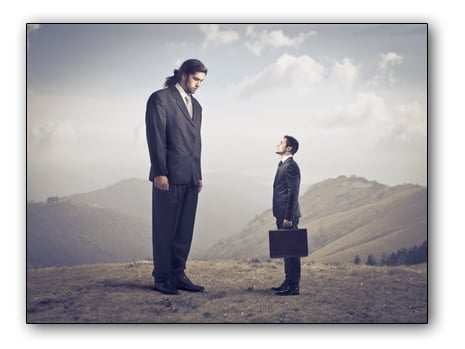We often hear from clients or prospective clients that it won’t help them if they look like a big company that is attempting to overwhelm or dazzle its opponents with technology. Jurors won’t buy that sort of stuff, we are told, even from a litigant that is actually a large company.
But although some may think that if the other side can present a “David vs. Goliath” story line, a major corporation will end up in danger of losing its case, research suggests that this is not so. In the first place, jurors have a pretty good idea about which corporations are large ones, and it won’t help to “hide the ball.”
In the second place, this sort of argument made more sense a decade or more in the past, when technology was just getting a foothold in America. Now, technology is simply a fact of daily existence, and jurors expect to see it.
In 2011, 78 percent of Americans used the Internet regularly, and just over 50 percent of Americans used Facebook. Forty-four percent of Americans owned a smartphone, up all the way from 18 percent just two years before. And these numbers are only going to go up.
Dr. Lou Genevie, a voir dire and trial consulting expert and founder of Litstrat, noted, "In our research, big companies that try to play small often pay a high price in a further erosion of their credibility. Finding the visual porridge for a big company that feels and looks 'just right' is a challenging process, very case specific, and the reason for testing the visual case long before rolling it out at the actual trial."
Trial consultant David Davis, a founder of R&D Strategic Solutions in Lexington, Mass., recalls: “In an agricultural area of Oklahoma, we worked for a client who was concerned about how their exhibits would be received by the jury and whether it would make the client appear to be slick and wealthy. In post-trial juror interviews we found there had been no problem. One juror commented, ‘I see better things on my computer every day.’ ”
Trial Behavior Consulting's Sarah Murray, a social and cultural anthropologist recognized for her expertise in trial strategy, jury selection, witness preparation and visual communication, says, “My research and experience over the years consistently show that jurors like well-executed graphics and that a "David vs. Goliath" scenario is not a problem. The problem is when a team has not well thought out its graphics or graphic communication strategy and has a lot of graphics that go nowhere but show that a lot of money has been thrown at the case.”
In a similar vein, a litigation support specialist for a United States Attorney’s office has written in the United States Attorneys’ Bulletin [pdf] “There is always some concern that using technology … will make the government look too slick or fuel the argument from defense counsel of the ‘vast resources of the federal government.’ In reality, the jury expects the government to be prepared and smooth in presenting the case to them. They already know that the government has resources.”
Thus, this supposed David versus Goliath issue ultimately doesn’t appear to us to be as significant as it once might have been, for either the David who is considering using its status to its advantage, or the Goliath who is concerned about appearing a giant. High quality preparation, irespective of stature, is what today's judges and juries are looking for and expecting.
See also: Trial Presentation Too Slick? Here's Why You Can Stop Worrying







Leave a Comment